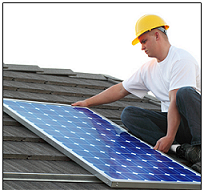What are solar Panels?
Solar panels or Solar modules are man
made panels which use the property of
certain material to produce DC electricity
when light falls on them.
It so happens that in these materials the
electrons that orbit the atoms
enhance the energy level when
photons (light particles) of the solar or any other light fall on them.
This energy is released later as electricity when right conditions are made available.
The electricity produced by solar cells made up of material possessing this useful property,
is interconnected electricity to provide a higher voltage or current.
The property of generating electricity when light energy falls on a substrate is called Photo Voltaic action and therefore the panels are also more commonly known as PV Panels (modules).
What material generates electricity by Photovoltaic action?
There are many Photo voltaic material now in the market. Typical examples are:
- Mono crystalline Silicon(Si)
- Poly crystalline Silicon (Si)
- Amorphous Silicon (a:Si)
- Cadmium Teluride (CdTe)
- Copper indium Gallium Selenide/Sulphide (CIGS)
Irrespective of the chemical composition the PV panels are also categorized according to the physical structure as SiWafers (incorporating the first named two and others) and as the broad umbrella of Thin Film types (to which belong the last named three and others)
What is an array of solar modules?
DC electricity produced by either a solar cell or a module of electrically interconnected solar cells is barely sufficient even for a low end job requiring electrical power like the operation of a telephone, for a short while. On the other hand, a house having a peak demand of 4 kw may need about 34 m2 of PV Panel surface area to cater for that demand. (This includes the 4 % or so power wasted at the inverter, while converting DC to AC). As a typical polycrystalline PV Panel producing 50 Wp has dimensions 0.96m X 0.36 m X 0.055 m, many interconnected modules will be necessary to cater for this demand. Such a collection of panels is known as an array of PV modules.
Basic Components of a Solar Panel Installation
- Solar Panels or Arrays-which produce DC electricity
- Inverter –Which convert the DC electricity to AC generally used in houses and Business establishments.
- Power Storage– in Batter packs which is an application mostly in remote off-grid installations.
- Interconnecting cables and accessories- to interconnect PV modules, the array and the Inverter,Inverter and battery packs, and inverter and the power grid.
Advantages of Solar Panels as a source of power generation
- solar energy is the cleanest source of energy and is available almost anywhere in the world freely.
The medium of conversion of this energy to electrical energy necessitates the use of expensive solar panels.
However this price is falling down drastically due to mass production, development of more efficient panels, - increased demand and subsidies made available including feed–in tariffs.Hardly any maintenance is
necessary during the guaranteed life span of 25 years of good makes.
Others too offer at least 15 years warranty. There are no moving parts except in large arrays where tracking is employed. Only accidental mechanical damage, corrosion, obscuring of the panel surface by dust and other impurities need to be looked into. - A concentrator type design employing reflector dishes could increase the cost effectiveness of Silicon
solar panel arrays five fold approximately.This makes it at par with the cost of energy generated by natural gas and other fossil fuel powered installations. - For remote off grid installations PV panels are the most viable when compared with fuel transport cost,
cost of power lines or lost power in transmission etc. of other system. For satellites and such special applications there is no other alternative! - The primary energy i.e solar energy is absolutely free to us. It is said if 195,000 km2 of 9,000,000 million km2 of uninhabited area of the Sahara is covered with PV panels, it can provide the total power demand of the world right now amounting to 13.5 Terawatts.(This is inclusive all power expended by means of oil, gas, coal, nuclear, biomass etc.) Unbelievable but it is a fact.
Disadvantages
- The capital investment is high due to the relatively high price of solar modules. (But this is coming down drastically.
What was $ 7.5/w for mono crystalline silicon modules installed in 2006 is only $ 2/w (FOB ex Factory PRC) today. So the pay back period is too reduced accordingly). - Obviously night is not a good time for solar energy. A power storage arrangement (with battery packs) is therefore necessary if the system is not grid tied.
- The power out put decreases with time to approximately 80% of the rated in about 25 years time.
If you are concerned with the environment (you should be when faced with catastrophes like the BP
crude oil leak in the Gulf of Mexico), you will realize renewable energy sources pose the least threat.
The fact is the worst of fossil fuels to the human civilization is yet to come.
An all this when this planet is not ours alone at all to play about with.
Greentech is your friendly advisor on Solar Power, about the best renewable
energy form with hardly any strings attached. Contact us with your problems for viable solutions.


